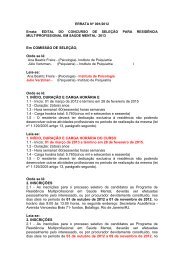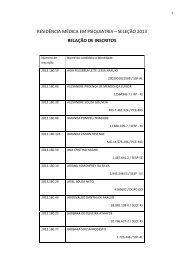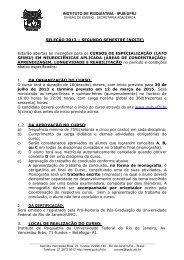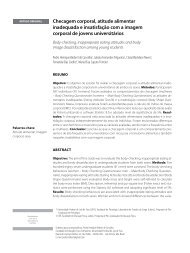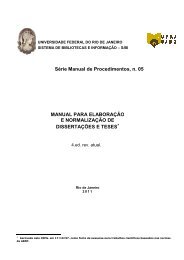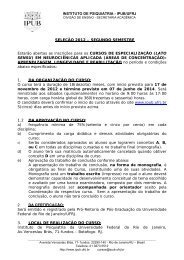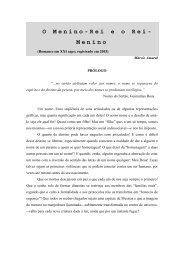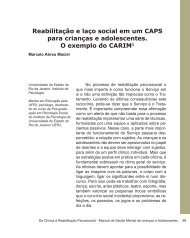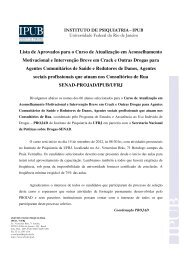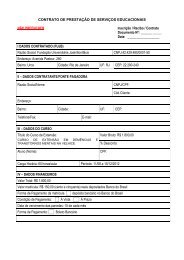Originais â Originals outubro | dezembro ⢠2011 - IPUB - UFRJ
Originais â Originals outubro | dezembro ⢠2011 - IPUB - UFRJ
Originais â Originals outubro | dezembro ⢠2011 - IPUB - UFRJ
You also want an ePaper? Increase the reach of your titles
YUMPU automatically turns print PDFs into web optimized ePapers that Google loves.
318 Laus MF et al.<br />
ORIGINAL ARTICLE<br />
Still on table 1, it can be seen that, according to the CDS,<br />
girls would like to have a lower BMI than they think they have.<br />
Body image data were then submitted to one-way (dissatisfaction<br />
x gender) ANOVA to determine possible differences<br />
in dissatisfaction between boys and girls. Table 1 shows that<br />
boys and girls differed significantly in body dissatisfaction<br />
[F (1,273)<br />
= 11,26; p < .001)], with girls reporting higher levels of<br />
dissatisfaction than boys.<br />
In order to evaluate differences in body image dissatisfaction<br />
between boys and girls who currently do and do<br />
not participate in some form of physical activity, a two-way<br />
ANOVA was performed. As can be seen, ANOVA revealed no<br />
significant effect of the body image dissatisfaction x physical<br />
activity levels x gender interaction (p > .05) which indicates<br />
that, in this sample, dissatisfaction exist regardless physical<br />
activity level or gender (Table 2).<br />
Table 2. Means (and Standard Deviations) for body image<br />
dissatisfaction (in kg/m 2 ) of boys and girls according to physical<br />
activity level and nutritional status<br />
Physical activity level<br />
Boys<br />
(n = 139)<br />
Body image dissatisfaction<br />
Girls<br />
(n = 136)<br />
Sedentary -6.3 (1.6) -1.9 (1.9)<br />
Low activity -0.8 (1.2) -1.8 (0.7)<br />
Moderate activity 0.0 (0.7) -3.2 (0.8)<br />
High activity 0.6 (0.7) -2.2 (0.8)<br />
Nutritional status<br />
Underweight 6.0 (1.3) a 0.0 (0.0) a<br />
Normal weight 1.2 (1.3) a -1.5 (0.5) a<br />
Risk of overweight -4.5 (1.1) b -7.4 (1.3) b<br />
Overweight -11.4 (1.8) b -8.5 (1.0) b<br />
a, b<br />
p < .05 (means with different superscripts differ significantly).<br />
A two-way ANOVA also was conducted to determine differences<br />
in body image dissatisfaction between boys and<br />
girls according to the nutritional status. As can be seen on<br />
table 2, ANOVA demonstrated no significant effect of gender<br />
(p > .05) but revealed a significant effect of the dissatisfaction<br />
x nutritional status interaction [F (3,267)<br />
= 31.71; p < .05]. Posthoc<br />
analysis showed that respondents with higher BMI were<br />
more dissatisfied with their weight than respondents with<br />
lower BMI. As expected, underweight and normal weight<br />
boys would like to be heavier, while those overweight would<br />
like to be thinner. In contrast, girls would like to be thinner,<br />
even when they are normal weight.<br />
Significant correlations were observed between body<br />
image dissatisfaction and BMI in boys (r = -.79) and girls (r =<br />
-.60), indicating that, in this sample, dissatisfaction with body<br />
image proportionally increased with increasing BMI in both<br />
sexes (p < .05) (Table 3).<br />
Table 3. Pearson’s correlation coefficients between body mass<br />
index (kg/m 2 ) and body image dissatisfaction (kg/m 2 ) for boys<br />
and girls<br />
Boys<br />
Body image dissatisfaction<br />
Girls<br />
Body mass index -.79 a -.60 a<br />
a<br />
Significant at p < .05.<br />
DISCUSSION<br />
The objective of the present study was to investigate body<br />
image dissatisfaction and its relationship with physical activity<br />
and body mass index in a Brazilian sample of adolescents.<br />
The results showed a large proportion of adolescents engaged<br />
in some form of physical activity and that most participants<br />
were of normal weight. Body image dissatisfaction<br />
was strictly related to BMI, but not to physical activity.<br />
Our data concerning the levels of physical activity of adolescents<br />
tested by the IPAQ agree with other national studies<br />
18 . Thus, it is important to note that there is a difference<br />
between “physical activity” and “exercise”. Caspersen et al. 19<br />
define physical activity as any bodily movement produced<br />
by skeletal muscles that results in energy expenditure. In<br />
daily life it can be categorized into occupational, sports, conditioning,<br />
household, or other activities. On the other hand,<br />
exer cise is a subcategory of physical activity. In fact, both<br />
have a number of common elements; however, exercise<br />
is not synonymous with physical activity. Exercise is physical<br />
activity that is planned, structured, repetitive, and intentional,<br />
in the sense that improvement or maintenance of<br />
one or more components of physical fitness is an objective 19 .<br />
The IPAQ is a measure of total physical activity and includes<br />
transportation and occupational physical activities making<br />
no distinction between the two terms.<br />
Particularly in developing countries, occupational and<br />
transportation activities represent a substantial proportion<br />
of total physical activity 20 . Thus, most of the participants possibly<br />
practice this kind of activity, and not specifically “exercise”.<br />
Since it is known that exercise is more often performed<br />
for appearance-related reasons 21 compared to physical activities,<br />
this could be one explanation for the lacking relationship<br />
between physical activity and body image disturbance.<br />
Concerning nutritional status, Madrigal et al. 22 have<br />
pointed out that the relationship between body weight and<br />
body image self-perception is well-documented in the literature,<br />
as confirmed in the present study. The present study<br />
shows that body dissatisfaction scores of both boys and<br />
girls were significantly correlated with their BMI, indicating<br />
that body image disturbance increases with increasing BMI.<br />
Similarly, previous studies have also found a direct relationship<br />
between BMI and body image disturbance 23,24 . A review<br />
conducted by Wardle 25 examining recent empirical evidence<br />
J Bras Psiquiatr. <strong>2011</strong>;60(4):315-20.




